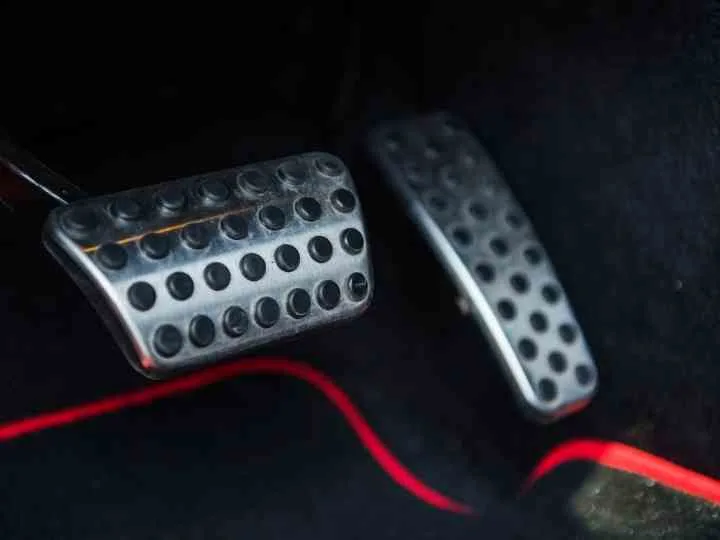The adaptive cruise control (ACC) technology is still not flawless despite being close to three decades old. Its public adoption was slow as it was initially expensive and only reserved for expensive luxury cars.
But here we are, and almost all new vehicles have the feature. And unlike standard cruise control, adaptive cruise control accelerates a vehicle to match the preset speed or the speed of a lead car.
How does it accelerate or decelerate? If you’re not sure whether your car’s adaptive cruise control uses brakes or not, here’s all you need to know.
Adaptive cruise control is a safety system that automatically takes over the acceleration and braking of a vehicle. Where necessary, such as in a situation that requires hard deceleration, it will automatically activate your car’s braking system. It may bring your car to a complete stop.
Read on to find out how adaptive cruise control brakes in stop-and-go traffic, whether it shows brake lights, and when it can fail.
How Adaptive Cruise Control Brakes in Stop-and-Go Traffic
Adaptive cruise control is an excellent feature in stop-and-go traffic as it can decelerate and accelerate a car with no human intervention. Your car will decelerate and come to a stop behind a lead car while keeping a preset following distance.
It will then accelerate and match the speed of the lead car up to your set cruising speed if the stop lasts less than 3 seconds.
After that, your car will electronically keep the throttle at this speed until it detects an obstacle or you deactivate the system using a deactivation button on your steering wheel.
Also, pressing the brake pedal deactivates the adaptive cruise control.
Does Adaptive Cruise Control Show Brake Lights?
Adaptive cruise control will only show brake lights under a greater deceleration when it activates your car’s brakes. If under moderate or minimal deceleration, your car will engine brake and won’t show brake lights.
For example, if you’re cruising behind another vehicle on the highway with an active ACC, your car’s braking will depend on how the lead vehicle brakes. If you are cruising at 85 miles per hour and your ACC system detects that there’s a slower car ahead of you and in your lane, it will gradually match its speed.
In this case, your brake lights won’t show as it’s similar to rolling off the throttle.
However, while cruising behind the vehicle, another car suddenly squeezes itself between your car and the lead car, the ACC system will apply the brakes. In this case, the brake lights will come on.
What if the Brake Lights Don’t Come On on Hard Deceleration

Brake lights are a safety feature that’s in place to inform other road users that you’re decelerating. Suppose they fail to show while braking, your chances of being rear-ended are very high.
Additionally, the federal law mandates that all road-worthy vehicles have functional brake lights to inform other drivers that the car ahead is braking. You may be liable if your brake lights are malfunctioning and you’re rear-ended or cause an accident because the driver that’s behind you swerved to avoid crashing into your car.
However, the law is quite clear and against tailgating. The vehicle driver that rear-ends you might be liable if they followed too closely.
However, under normal driving, it’s your fault if they can prove that your car’s braking lights weren’t functioning at the time of the accident.
Furthermore, car manufacturers would be in a lot of trouble if their adaptive cruise control equipped cars failed to show brake lights on hard deceleration.
When Does Adaptive Cruise Control Fail To Brake?
Adaptive cruise control isn’t as flawless as you might assume. You’ll still need to be vigilant while on the road as the system has the following limitations.
It May Fail To Detect an Oncoming Vehicle
Adaptive cruise control will only detect vehicles in your lane and moving in the same direction as yourself.
Therefore, if there’s an oncoming vehicle, the chances of a crash occurring are very high as your car won’t brake on its own.
Road Infrastructures
Though it may be rare, road infrastructures such as tunnels and bridges may cause the system to brake later than expected. You should always control the vehicle in areas with safety barriers or unpredictable road conditions.
Offset Cars
The radar sensors may fail to detect a car that’s offset in your lane, such as vehicles on the edge of the lane. The sensors have a limited field of view and may fail to detect such vehicles causing your vehicle to accelerate into the offset car.
However, this is rare since ACC is often paired with front Collision Avoidance Systems (CAS).
Stationary Cars
ACC systems, by design, won’t detect stationary objects on the road to prevent unnecessary stops while cruising at high speeds.
Therefore, if you’re cruising at 70 miles per hour and you come across a stationary car on the road, your car will rely on other Advanced Driver Assistance Systems (ADAS) to stop the car.
On the contrary, ACC systems will detect stationary objects only while cruising at low speeds (below 20 miles per hour).
Motorcycles and Pedestrians
On its own, the adaptive cruise control may fail to detect pedestrians and motorcycles on the road.
Luckily, it’s often paired with other sophisticated driving assist technologies such as Pre-Collision Assist with Pedestrian Detection to overcome this shortcoming.
Does Adaptive Cruise Control Engine Brake?

Absolutely!
Engine braking is decelerating your vehicle by stepping off the gas pedal and downshifting your gears instead of stepping on the brake pedal.
Cars equipped with adaptive cruise control decelerate by electronically limiting airflow into the engine cylinders and saving on the brakes. The limited airflow creates a vacuum that the pistons will be working against in the cylinders.
And since it limits the movement of the engine components, the engine power will get less and less; hence you’ll notice your car decelerating.
Engine braking is very useful, especially when going downhill. Unlike traditional cruise control which lacks this feature, adaptive cruise control improves brake life with smooth engine braking.
Its downside is that cars with standard cruise control tend to accelerate past the set cruising speed on a downhill trajectory. As a result, many drivers prefer to brake manually and disengage the cruise control for their safety.
Engine braking with adaptive cruise control saves on your brakes as they tend to overheat when pressed in on a steep descent. You don’t have to disengage your driver-assist features with adaptive cruise control.
Final Remarks
A car equipped with an adaptive cruise control system isn’t an autonomous vehicle. At all times, be vigilant while on the road since you’ll be liable for any accidents that result from your driving.
Also, some cars provide you with an option between standard cruise control and adaptive cruise control.
Choose the right feature before going on the road. Remember, cruise control keeps your vehicle at a preset speed and will not brake when it’s necessary to do so.
On the other hand, adaptive cruise control may fail to activate the brakes in time, and you shouldn’t use it when entering or leaving the highway. Furthermore, don’t zone off while cruising, adaptive cruise control is a driver assist feature, not a substitute for attentive driving.
